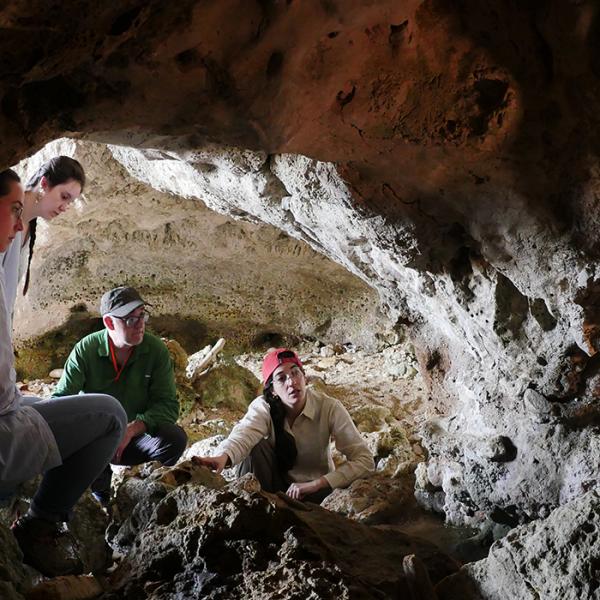Through their research at a 3,000-year-old monumental site built by indigenous peoples, anthropology graduate students Seth Grooms and Grace Ward have found an important example of complex cultural achievement occurring in the absence of coercive labor.
When we encounter impressive monuments like the Egyptian pyramids or the Great Wall of China, what do we assume about the societies that created them? According to anthropology graduate students Seth Grooms and Grace Ward, Western thought has trained us to view these cultural achievements as inextricably linked to social hierarchies.
“Because complex architectural projects require so much labor, we assume that someone needs to monopolize power and control the work of others to construct them,” said Ward, a seventh-year graduate student in archaeology working with Tristram R. Kidder, the Edward S. and Tedi Macias Professor of Anthropology. “From that perspective, monuments are always political tools for getting surrounding communities to fall in line and follow the leadership of a singular political body.”
While this model of top-down social complexity is useful for understanding our own society, Ward said, there is no reason to assume it would universally apply to ancient cultures around the world. Through excavations of earthen monuments built by indigenous peoples over 3,000 years ago, Ward and Grooms have helped identify a crucial exception to Western narratives of cultural achievement.
“The site we studied, Poverty Point, is a UNESCO World Heritage Site in modern-day Louisiana. It is one of the largest monumental sites in the world, and we know unequivocally that it was built by a non-hierarchical foraging society,” said Grooms, a recently graduated archaeology student who also worked with Kidder.
Grooms and Ward came to this conclusion after comparing archeological evidence from the site to established models of social hierarchy. “If you look at the archeology of cities in medieval Western Europe, for example, you have signs of a fortified central space for elites, with other spaces that are clearly for a subject population,” said Ward. “At Poverty Point, on the other hand, there is little evidence of a concentration of artifacts or architecture that is differentiated from the rest of the site.”

Furthermore, preserved plant remains at the site are characteristic of a society that produced its food by foraging wild resources in a forest environment. This contradicts the traditional expectation that complex societies must farm crops in a controlled and predictable way. “From global examples, we know that you can manage a forest,” said Ward. “And the idea that Poverty Point had a centrally controlled system of food production doesn't match the ecological dynamics we would expect in a forested landscape.”
As for the monuments themselves, there is no evidence that anyone was buried in them, or that any structure was built on the largest mound at the site. “That should be a red flag for anyone thinking of the monuments as commemorating an elite political body,” said Grooms
There is, however, evidence that the construction of the monuments required incredibly complex social coordination. “The archaeological facts of the situation are that people came together and built these massive monuments very quickly, with almost no breaks in the construction process,” said Grooms. Interestingly, the team says, artifacts at Poverty Point have been traced back to sites across eastern North America and beyond, suggesting distinct ethnic groups traveled great distances to work collaboratively on the monuments.
“This isn't a socially simple situation, which tends to be the expectation for foraging societies,” said Grooms. “These people came together to build these incredible monuments, and according to the archaeological evidence, they did it in the absence of any kind of institutional hierarchy, wealth differences, or intensive agricultural systems. All of that was once thought to be a prerequisite for social complexity.”
“We have evidence of a massive collective project being constructed without the exploitation of anybody's labor,” said Ward. “That's pretty huge.”
This clear discrepancy from Western thought traditions prompted Grooms and Ward to turn to Native American philosophy for answers. “There are around 570 indigenous tribes in the U.S., and they have very diverse intellectual and cultural identities,” said Grooms, who teaches a class on Native American philosophy. “But just as we can group Immanuel Kant and Socrates together as Western thinkers, we can look for commonalities in Native American worldviews writ large.”
Specifically, the researchers became interested in Native American conceptions of how power operates in society. “In native political philosophy, power works for the collective, not the individual,” said Ward. “It manifests as something internal to groups of people who come together, as opposed to something external or stratified. That’s a fundamental shift in how we think about power; we don’t see it in European-derived philosophy until after colonial encounters with indigenous societies.”
By reimagining power as a mechanism of collaboration instead of coercion, we can understand how elaborate monuments like those at Poverty Point could be built in the absence of hierarchical authority.
“You can think of it as a bottom-up model of consensus and cooperation instead of a top-down model of social hierarchy,” said Grooms. “It’s an extraordinary testament to human ingenuity, capacity for cooperation, and social creativity right in front of our eyes.”
“If there's any kind of mental block in the way people think about what they can work towards politically, we feel like this historical example should open up the range of potential configurations for relating to each other,” said Ward. “When we see harmful, exploitative forms of social structure, we can say, ‘Actually, it doesn’t have to be that way.’”



